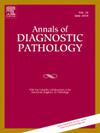Evaluating the role of cytology in diagnosing primary lung carcinoma with special reference to the 2023 WHO lung cytology reporting categories
IF 1.4
4区 医学
Q3 PATHOLOGY
引用次数: 0
Abstract
Diagnosing lung carcinoma in cytology specimens is notably challenging. In response, the World Health Organization (WHO) introduced reformulated categories in 2023 that reflect varying malignancy risks. To evaluate this revised classification, it is vital to correlate cytological results with biopsy findings. In this study, we reclassified previously diagnosed cases based on the new WHO cytological categories. Prospective cross-sectional study evaluated cytology samples from lung carcinoma patients at AIIMS Raipur (2019–2021) and, in 2024, reclassified them according to updated WHO categories, facilitating a new assessment of cytology sensitivity through descriptive statistics and calculations. In this study, 116 biopsy-confirmed primary lung carcinoma cases underwent cytological evaluation, with cell blocks prepared for 70 cases. Sample types included bronchoalveolar lavage (BAL) fluid (68 cases, 58.6 %), sputum (4 cases, 3.4 %), and fine needle aspiration cytology (4 cases, 3.4 %); remaining samples were pleural fluid, which were subsequently excluded. Following the adoption of new WHO classification categories in 2024, a retrospective analysis demonstrated a significant improvement in sensitivity, increasing from 36.8 % (28/76) to 65.8 % (50/76), which enhanced the detection of atypical, suspicious, or malignant cases. This study underscores the effectiveness and limitations of cytological examination in diagnosing primary lung carcinoma, demonstrating that many cases can be accurately identified. The new WHO cytology categories improve diagnostic accuracy, but sensitivity results suggest room for precision enhancement. BAL fluid's low sensitivity for peripheral lesions underscores the need for alternative sampling methods.
评估细胞学在原发性肺癌诊断中的作用,特别参考2023年WHO肺细胞学报告类别
在细胞学标本中诊断肺癌是非常具有挑战性的。作为回应,世界卫生组织(世卫组织)在2023年引入了重新制定的类别,反映了不同的恶性肿瘤风险。为了评估这种修订后的分类,将细胞学结果与活检结果联系起来是至关重要的。在这项研究中,我们根据新的WHO细胞学分类对以前诊断的病例进行了重新分类。前瞻性横断面研究评估了AIIMS Raipur(2019-2021)肺癌患者的细胞学样本,并于2024年根据更新的世卫组织分类对其进行了重新分类,通过描述性统计和计算促进了细胞学敏感性的新评估。在本研究中,116例活检证实的原发性肺癌患者进行了细胞学评估,其中70例准备了细胞块。样本类型包括支气管肺泡灌洗液(68例,58.6%)、痰液(4例,3.4%)和细针吸痰细胞学(4例,3.4%);剩余的样本是胸腔积液,随后被排除。在2024年采用新的世卫组织分类类别之后,回顾性分析表明敏感性显著提高,从36.8%(28/76)增加到65.8%(50/76),这加强了对非典型、可疑或恶性病例的发现。本研究强调了细胞学检查在诊断原发性肺癌中的有效性和局限性,表明许多病例可以准确识别。新的世卫组织细胞学分类提高了诊断的准确性,但敏感性结果表明精度有提高的余地。BAL液对周围病变的低敏感性强调了对替代采样方法的需求。
本文章由计算机程序翻译,如有差异,请以英文原文为准。
求助全文
约1分钟内获得全文
求助全文
来源期刊
CiteScore
3.90
自引率
5.00%
发文量
149
审稿时长
26 days
期刊介绍:
A peer-reviewed journal devoted to the publication of articles dealing with traditional morphologic studies using standard diagnostic techniques and stressing clinicopathological correlations and scientific observation of relevance to the daily practice of pathology. Special features include pathologic-radiologic correlations and pathologic-cytologic correlations.

 求助内容:
求助内容: 应助结果提醒方式:
应助结果提醒方式:


